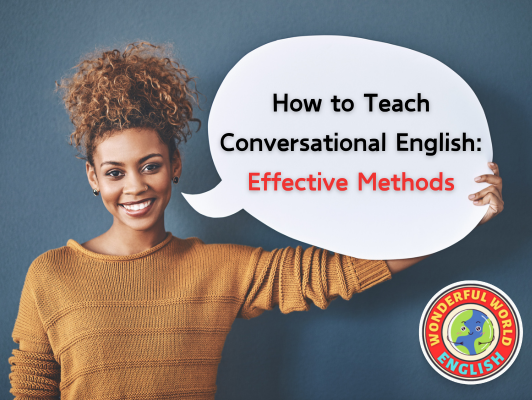Contents
Toggle
Meet David De’ Ath, founder, editor, and writer at Wonderful World English. With his extensive background as an English teacher, David provides valuable insights and practical tips on ESL for students and teachers alike.
Teaching conversational English can be one of the most rewarding elements of language education, promoting real-world communication skills essential for students’ success in a global environment.
It encompasses much more than vocabulary and grammar; it’s about the application of language in authentic, dynamic interactions.
Educators must strike a balance between structure and spontaneity to simulate natural speech and facilitate meaningful exchanges.
Conversation classes often focus on fluency and the ability to express ideas coherently, rather than on perfect grammatical precision.
An effective approach to conversational English teaching involves crafting lesson plans that encourage active participation and employ diverse techniques tailored to different learning levels.
Choosing pertinent and engaging topics can significantly increase student talking time, ensuring that learners of all proficiencies have the opportunity to speak and listen in scenarios that mirror real-life situations.
Additionally, employing an array of instructional resources and digital tools can enhance the learning experience and provide vital support to both teachers and students in the journey towards conversational proficiency.
Key Takeaways
- Conversational English teaching prioritizes fluency and student engagement.
- Diverse teaching strategies cater to a range of learner abilities.
- A well-equipped educator utilizes various resources to enhance instruction.
Understanding the Basics of Conversational English
Conversational English focuses on the fluency and understanding necessary for real-life interactions.
It emphasizes the practical use of language and the development of listening and speaking skills.
The Art of Teaching Language Skills
Teaching conversational English requires a balance between structured language instruction and opportunities for spontaneous dialogue.
Key language skills include:
- Listening: Understanding spoken English through a variety of accents, idioms, and speeds.
- Speaking: Expressing thoughts clearly and accurately in interactive settings.
Teachers should integrate listening and speaking activities that reflect everyday communication, preparing students for authentic conversations.
Differences Between Conversational and Formal English
Conversational English:
- Uses informal language and slang.
- Emphasizes clarity and brevity.
- Tolerates grammatical flexibility for the sake of natural speech patterns.
Formal English:
- Follows stricter grammatical rules.
- Utilizes a more extensive vocabulary.
- Often found in written texts, formal speeches, and academic settings.
Educators need to help students navigate the nuances between casual conversation and formal discourse, ensuring they can adapt their language use to different contexts.

Developing Effective Lesson Plans
An effective lesson plan in conversational English hinges on creating a structured framework that incorporates engaging topics and activities while also outlining strategies for assessment and feedback.
The goal is to foster a learning environment where students feel confident to participate and improve their language skills.
Incorporating Engaging Topics and Activities
It is crucial to select topics that resonate with students’ interests and experiences to fuel engaging conversations.
These might include current events, cultural differences, or practical life scenarios.
For activities, teachers can employ the Presentation, Practice, and Production (PPP) method to introduce and practice new concepts in a clear order.
The inclusion of role-plays, simulations, or debates allows students to apply language skills in realistic contexts, thereby reinforcing their conversational abilities.
Assessment and Feedback Strategies
Assessment in conversational English should focus on students’ ability to communicate effectively rather than just grammatical correctness.
Teachers might assess through observing participation during activities or by using speaking tasks assessments.
Constructive feedback is essential and should be delivered in a manner that encourages students without discouraging them from taking risks with their language use.
Teachers should record observations and progress after each lesson to adjust future plans and provide targeted feedback, helping students to continuously improve their conversational skills.

Techniques for Increasing Student Talking Time
To enhance students’ fluency in English, it is crucial to maximize their talking time in the classroom.
Strategies that foster student interaction and incorporate dynamic activities are key to achieving this.
Encouraging Interaction and Small Talk
Instructors should cultivate an environment where students feel comfortable engaging in small talk.
This can be achieved by starting each class with a brief session of informal conversation, allowing students to discuss topics such as the weather, current events, or personal interests.
For example, teachers might pose an open-ended question like, “What was the highlight of your weekend?” to kickstart dialogue.
This not only warms up the class but also helps students to practice spontaneous English in a relaxed setting.
Related: How to Improve Vocabulary in 30 Days: Ultimate Guide
Using Games and Real-life Scenarios
Incorporating games into lessons is an effective approach to increase student talking time and heighten engagement.
Games like role-play simulations, which mirror real-life scenarios, urge students to utilize English in practical contexts.
For instance, setting up a ‘restaurant scenario’ where some students are customers and others are waiters encourages them to communicate needs and preferences.
Through these playful yet educational activities, students are more likely to use a variety of expressions and vocabulary, thus enhancing their conversational skills.
Games can be excellent tools both in and out of the classroom.
For our complete list of the BEST games to learn English, check out the link below!
Related: Best Games to Learn English: Ultimate Guide

Effective Strategies for Different Learning Levels
When teaching conversational English, educators must tailor their strategies to effectively meet the learning needs across varying levels.
They should consider the range of proficiency from beginners to advanced students, employing distinct approaches that promote engagement and provide appropriate feedback.
Adapting to Beginners and Intermediate Students
For beginners and intermediate learners, one must focus on building a solid foundation.
Teachers should:
- Provide visual aids and real-life contexts to help them better understand and use new vocabulary.
- Use simple sentences and clear instructions to ensure comprehension.
- Model conversations and encourage role-play to simulate real-life scenarios.
Intermediate students, while possessing a foundation, benefit from:
- Themed conversations that challenge them to expand their vocabulary and usage.
- Feedback highlighting both correct usage and areas for improvement, aiming not just to correct but to build confidence.
Challenges and Approaches for Advanced Learners
Advanced learners require a different set of strategies:
- Introduce complex subjects that encourage critical thinking and nuanced expression.
- Debate and discussion formats can push advanced students to articulate more complex ideas.
- Constructive feedback should focus on subtle language nuances, like idiomatic expressions or stylistic choices, that these learners can incorporate to sound more like native speakers.

Resources and Tools for Teaching English Conversation
Selecting the right resources and tools is essential for effectively teaching conversational English.
Educators can leverage various multimedia platforms and a well-formulated ESL conversation curriculum to facilitate engaging and educational experiences for their learners.
Utilizing Multimedia and Online Platforms
Multimedia resources such as videos, audio recordings, and interactive software have proven invaluable in teaching conversational English.
YouTube is a treasure trove of educational content where one can find countless video lessons aimed at enhancing conversational skills.
Teachers can curate playlists or recommend channels hosted by native English speakers that focus exclusively on conversation practice.
Online platforms designed for teaching conversational English online can be utilized for live interactions.
These platforms often allow for real-time feedback and interactive group sessions, where students can practice with peers and native speakers under the guidance of a tutor.
We also offer daily vocabulary lessons to our students on Instagram and TikTok!
Developing a Resourceful ESL Conversation Curriculum
Creating an ESL conversation curriculum requires a strategic approach that encompasses a variety of teaching materials.
A comprehensive textbook that focuses on conversation can serve as a core resource, around which supplemental activities and discussions are designed.
The curriculum should include:
- Real-life scenarios: Role-playing exercises reflecting everyday situations.
- Topical discussions: Guided debates on current events or culturally relevant topics.
- Vocabulary expansion: Contextual learning of new words and phrases.
By developing a curriculum that is both structured and adaptable, educators provide a pathway for learners to achieve fluency while adapting to the diverse needs of the students within an ESL conversation class.

Conclusion
Teaching conversational English is a dynamic and impactful endeavor that goes beyond traditional language instruction by emphasizing real-world application and fluency.
Successful educators in this field employ a variety of engaging techniques and create a supportive environment that encourages active participation.
By carefully selecting topics that resonate with students and utilizing diverse multimedia resources, teachers can greatly enhance the learning experience and effectively prepare students for practical communication in English.
Whether through structured lesson plans, interactive activities, or digital platforms, the goal remains to equip students with the confidence and skills to navigate diverse conversational settings.
Ultimately, the measure of success in teaching conversational English lies in the students’ ability to communicate effectively and confidently in their personal and professional lives.
We hope you find value in this information; you can contact us if you require any support.
Have a wonderful day!
Image Attribution: All images licensed via canva.com





